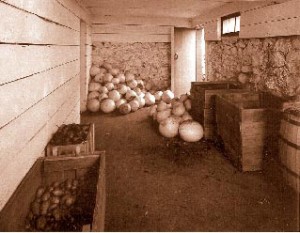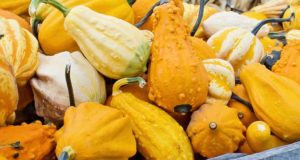Without the use of a refrigerator the modern world would probably teeter on the edge of chaos (only kidding, but maybe not far off), as we have become so accustomed to having modern conveniences, that we forget what it may have been like to not have them. Even without widespread energy concerns and while we have our modern refrigerators, there may still be a good usage for root cellars and for preparing ourselves with the mentality that perpetuates things like root cellars. It is better to have them now so that they are ready when we need them.
 It’s a long-time old-world practice to store root vegetables in optimum conditions to extract the maximum usable life out of them; this includes everything from carrots to onions, to beets, potatoes and turnips. It prevents freezing of vegetables, spoiling, flavor degradation, and allows harvests to be enjoyed more fully. For those with a large group to feed or a large garden that produces root vegetables, root cellaring actually makes more sense than modern refrigeration in some respects.
It’s a long-time old-world practice to store root vegetables in optimum conditions to extract the maximum usable life out of them; this includes everything from carrots to onions, to beets, potatoes and turnips. It prevents freezing of vegetables, spoiling, flavor degradation, and allows harvests to be enjoyed more fully. For those with a large group to feed or a large garden that produces root vegetables, root cellaring actually makes more sense than modern refrigeration in some respects.
Being able to eat biennials year round is another advantage of root cellaring. Biennial vegetables are those that set seed during their second growing season, yet have a hearty build, which means they are tailor-made for winter keeping in storage. Some would say that we are trying to disrupt the rules of nature by keeping beets, cabbage, and turnips to eat over the cold months. Essentially we are just cooperating with the vegetable’s actual intention to live another cycle and reproduce.
Not only are the sturdy root and core vegetables great candidates for root cellaring, you can also store celery, leeks, Brussels sprouts, peppers, grapes, and citrus fruits in a cold room for periods of two to eight weeks, depending on the type of vegetable and the conditions. Onions, garlic, squash, pumpkins, sweet potatoes, and green tomatoes will last until spring if you leave them in good conditions. This technique also works in climates where overheating can occur as well.
A root cellar is any storage location that mimics or uses the natural cooling, insulating, and humidifying properties of the earth. Ideally the cellar temperature would remain at 32 to 40 degrees Fahrenheit and have a relative humidity of 80 to 90 percent. This system works by slowing the release of ethylene gas and stopping the growth of microorganisms that cause decomposition. These effects are achieved through cool temperatures and low evaporative effects. The humidity level prevents loss of moisture through evaporation.
A root cellar isn’t entirely ineffective if it doesn’t meet the ideal conditions set out above, but it enhances its effectiveness when it can meet these conditions. Any amount of controlled environment will enhance the longevity of some fruits and most vegetables.
 Treat all winter-keeping vegetables gently at all stages of harvest, preparation, and storage, as bruised produce will spoil at an accelerated rate.
Treat all winter-keeping vegetables gently at all stages of harvest, preparation, and storage, as bruised produce will spoil at an accelerated rate.
- Store only your best fruits and vegetables. Bruised produce can affect your healthy produce.
- Only pick your produce at maturity, not to early and not too late.
- Harvest your produce if possible, during a dry spell.
- Always leave your vegetables in the garden as long as possible, but keep an eye out, as fall weather can get pretty cool, and your rescue may be too late.
- Always choose wide varieties of vegetables that are well-adapted for storage. Long-season beets and Penn State ballhead cabbage are good examples of great storage vegetables.
To prepare most root vegetables for winter storage, simply trim the green tops, leaving a one-inch stub (this will prevent decay). Be careful not to cut the root tips or root flesh, as this will invite spoilage. These basic steps will reduce the risk of spoiled food.
Constructing a Root Cellar
A buried fifty-five-gallon plastic drum with extra insulation could function as a root cellar, as well as an old clean refrigerator put into a position to not be heated. The goal is to maintain a cool environment without excess humidity. Using basic laws of evaporative cooling will enhance your makeshift cellar. Some ideas: a fully buried cellar, a multi-layered heavily insulated bucket system, or a fully constructed above ground “cellar”.
An extremely easy method of root cellaring can be found with the multiple pot design. Use one very large clay potter with a second smaller pot inside of it. Fill the area between the two pots filled with wet sand packed tightly and cover with several layers of heavy cloth to allow some moisture release. Vegetables and some fruits can have their useful life extended by more than threefold using this method.
Another viable alternative is the hay bale method, which uses tightly stacked and situated hay bales to create a freestanding room inside of the hay bale structure. A roof of 2×4’s and more hay bales creates a nearly ideal above ground root cellar, though you will need to line the inside walls with a rodent barrier and allow for an intake for cold air and an exhaust for hot air to be removed.
In prolonged survival conditions, it can be important to dial down the relative humidity to keep spoilage even lower and allow for some dehydration or shrinkage to occur.
Check your stock often just to be sure one apple (or turnip or carrot or potato) doesn’t spoil the rest.
For your apples, radishes, and beets, your storage time will be three months. Your squash, turnips, carrots, and potatoes should last up to five months in this mini-cellar.
More complex designs are certainly available to the average do-it-yourselfer. Concrete tends to be the preferred material due to its weather resistant and moisture tolerant construction. But clay, metal (when insulated properly), or wood framing can all be suitable if you utilize the correct engineering. It’s more about maintaining the humidity and regulating the temperature than what materials you use. Root vegetables and even other fruits and vegetables are hearty foods and can be prepared to outlast our thoughts of normal longevity. We should be thinking about these simplistic but efficient types of projects to be truly effective in our off-the-grid planning. It’s not necessary for everyone to build a root cellar, but smart planning and using energy-efficient or non-energy-reliant techniques for storing food are as important now as ever.
Don’t be afraid to entertain the idea of things like root cellars. More important than the immediate benefits is the creative experience and knowledge that comes from trying something like this, especially if it ever gets to the point where you actually need a root cellar or a root-cellaring mentality.
©2011 Off the Grid News
——————————————————————————————————-
Recipes From The Root Cellar
270 Fresh Ways to Enjoy Winter Vegetables
——————————————————————————————————–
 Off The Grid News Better Ideas For Off The Grid Living
Off The Grid News Better Ideas For Off The Grid Living



